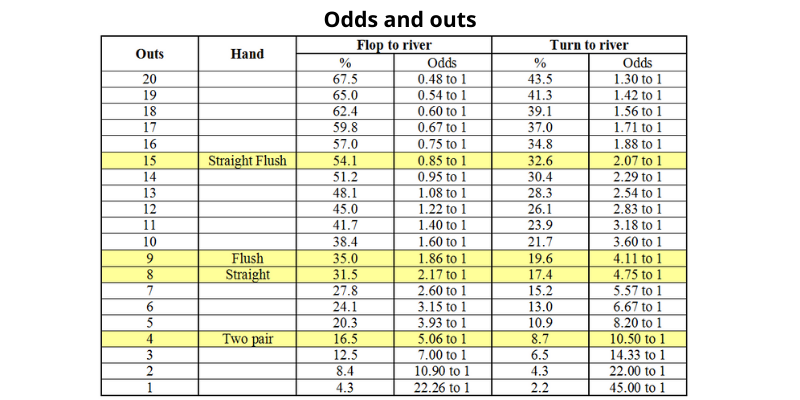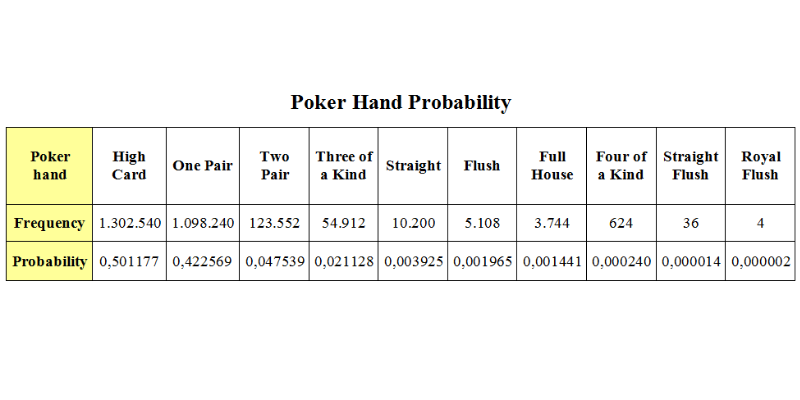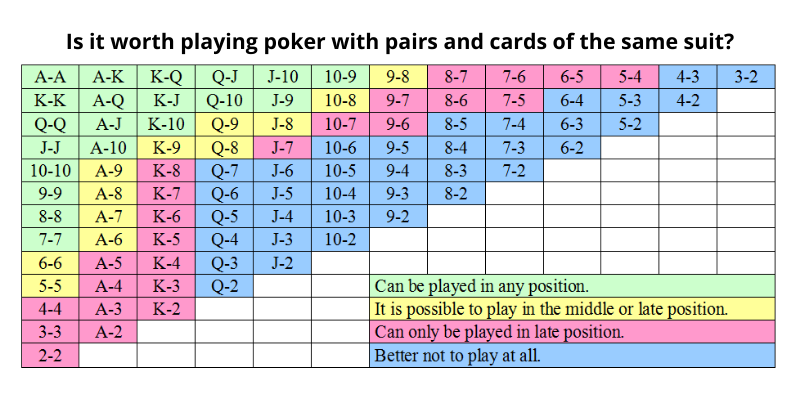Poker is a game of math. If you are to ever make any dollar from playing poker, it is imperative for you to know how to calculate odds in poker in addition to understanding what they are. Understanding poker maths will get you halfway to where you need to be. To get the best from poker, you need great pod odds and impressive winning odds on your side. Unfortunately, this barely happens until you are a smart player.

What is poker maths?
You don’t have to be a poker math genius to win poker. Winning in poker is all about understanding the odds, poker starting hands percentages and having solid probability knowledge. For beginners, poker mathematics can seem daunting until they pay attention to details.
Are you fond of playing poker but still confused about where to start? You are reading the right article. We are just about to drive you through the world of poker odds. This definitive poker odds guide will introduce to you all you need to hit a winning hand on both online and real tables. Keep reading!
What are poker odds?

Unlike in sports betting, poker is a game of probabilities and is not based on pure luck. With that said, poker odds refers to the price on offer or merely the likelihood that you can expect to win or lose. It is the relationship between the size of the pot and the bet facing you. In poker cases, every bet, raise or call that you make has its unique odds.
Poker odds are the most basic probability tool every player should have. Since poker is a mathematical gamble, poker players should constantly be thinking about their odds and those of opponents if they want to play well.
When playing poker, you should also be aware of pot size.
Poker How to calculate Odds ratio
Calculating poker odds and equity in hand is very crucial in necessitating statistically correct decisions. Although it won’t reveal your opponent’s hand or guarantee that you will win, it will offer insights into how advantageous your hand is. From a personalized point of view, the holistic concepts of poker odds are easier to understand when expressed in percentages rather than the usual ratio form. Fortunately, the process of converting ratio to percentages is relatively straightforward.
Here are steps that will make you a human poker odd calculator.
Step 1: Understand the percentages of your favorite poker game.
Calculating poker odds (poker probability calculation) chiefly depend on the game you are playing. Therefore, the game you are playing will be the reference point when calculating poker odds. For instance, getting a winning hand in Texas Holdem, the most popular poker game across the world, differs significantly from getting a winning hand in a 7-card stud.
Step 2: How to calculate outs in poker (poker hands percentages)
Knowing how to count outs in poker is very helpful. To calculate poker odds, you need first to determine the number of outs you have to make a winning hand (cards in the deck that may come on the turn or river). It is simple but requires little practice and attention to detail. You should also remember there are 13 cards for every suit and 4 cards for every value. To determine your outs, you need to carefully assess your hand after the flop and be keen not to count outs twice.

For instance, if you have;
- Flush draw. There are 13 cards per suit, of which you can see 4 cards (2 in your hand and 2 on the flop). With 4 suited cards, you have 9 (13 – 4) outs.
- Open-ended straight draw. In this case, two different values can make your hand winning, so you have 8 outs.
- 2 overcards. When you have 2 cards in your hand that are higher than any of the 3 flop cards, you have 3 outs.
- Ace pair. In total, there are 4 Ace’s, and you have one in your hand. This leaves 3 Aces unseen; therefore, giving you 3 outs for the turn and river.
- Flush and open-straight draw. In this case, you have 9 out for a flush and 6 outs to complete a straight, creating a total of 15 outs that can give you a winning hand.
Step 3: Determine the total unseen cards.
As simple as it sounds, you need to calculate determine the number of unseen cards. When determining the number of unseen cards, your point of reference should be the number of cards you can see. Therefore, cards in the hands of your opponents are ignored.

For instance, you can only see 6 cards (2 cards in your hand and 4 exposed from flop and turn).
Given 52 cards in the deck, 2 cards in your hand, and 4 cards from the flop and turn, you will have (52 – 2 – 4) =46 unseen cards.
Step 4: Calculate the odds ratio (Texas Holdem poker Odds)
You now have all the information you need to calculate the probability of getting the winning hand. In this case, you have 46 unseen cards of which 9 are outs (winning cards), and then 37 are losing cards. The probability of you getting one of the cards you need on the river is losing cards to outs, which is 37:9. When simplified, you get about 4:1, meaning you’re 4 times likely to lose than winning.
Step 5: Convert poker odds into a percentage
In this step, take the number representing your chance of winning (number on the right), divide it by the sum, and multiply by 100 to get the percentage. For example, 4:1 gives 20% (⅕ x100).

When to call the bet
Whether or not to call your opponent’s bet depends on the amount in the pot. Although there is no strict amount you should go for, you will want to check the possible win and compare it with the opponent’s bet.
For instance, if there is $90 in the pot, and the opponent wagers $10, which you need to match with $10 to stay in the game, it means your $10 bet could win you $100. Wagering with $10 means your opponent has given you 10:1 odd when your real winning chance is 4:1—an equivalent bookmaker giving 10:1 odds on a horse that has 4:1 winning probability.
Mathematics in poker – bottom line
Poker odds and pot odds are your best friends in any poker game. Keep an eye on what pot odds you are getting to make the right calls in poker. With the above poker maths tips, you will easily calculate poker odds and become a better poker player.
Frequently asked questions
❓ What starting pairs and cards of the same suit can be played in the starting poker positions?
- A-A;
- A-K;
- K-Q;
- Q-J;
- J-10;
- 10-9;
- K-K;
- A-Q;
- K-J;
- Q-10;
- J-9;
- Q-Q;
- A-J;
- K-10;
- J-J;
- A-10;
- 10-10;
- 9-9;
- 8-8;
- 7-7.
❓ What starting cards of the different suit can be played in the starting poker position?
- A-K;
- K-Q;
- A-Q;
- K-J;
- A-J;
- A-10.